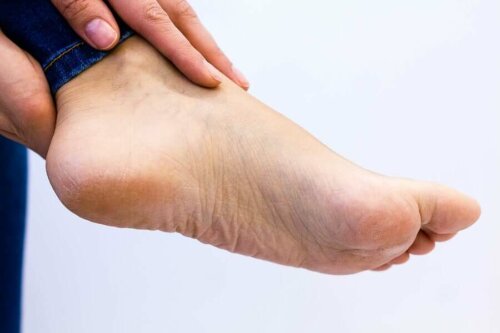What Causes Yellow Skin on the Bottom of the Feet


Written and verified by the doctor Leonardo Biolatto
Yellow skin in the bottom of the feet is quite common, and yet people seldom notice it. Most likely because it’s a part of the body we don’t pay much attention to. The soles of our feet often reflect metabolic problems, though, and so do the palms of the hands.
Color changes in the soles of the feet happen frequently and there are many causes for them. However, people are usually alarmed when they notice a yellowish color in this part. There’s no reason to lose your cool; in fact, this change doesn’t necessarily indicate a serious health condition.
Many of us will notice other’s yellow feet before we notice our own. This color is usually due to an excess of carotenes in the diet.
Carotenes are pigments present in many types of food — such as carrots. Today’s article will describe why and also discuss other causes of yellow skin on the bottom of the feet.
Carotenes and the soles of your feet
As we have mentioned above, hypercarotenemia is the most frequent cause of yellowish soles. This is a benign condition in people who have an excess of carotenes in their bodies.
Carotenes are pigments found in many types of fruit and vegetables and are usually responsible for their yellow or red color. For example, oranges, carrots, and sweet potatoes are particularly rich in this substance.

Hypercarotenemia usually arises after consuming a lot of carotenes. However, it’s most often associated with other diseases that increase this substance in the blood. For example, it often happens in people with hypothyroidism.
This condition has no symptoms other than the yellowish coloration we’re discussing. Furthermore, it usually affects the soles of the feet and palms of the hands. It’s transitory and only affects people at the aesthetic level.
Read about Hypervitaminosis: The Excess of Vitamins
What other causes are there for yellow feet?
Other situations change the color of the soles of the feet besides hypercarotenemia and some of them are indeed pathological. Jaundice is one, for example.
Jaundice is a medical term for the yellowing of the skin and mucous membranes and happens when bilirubin is above normal blood levels. Bilirubin is a yellow pigment found in the bile and acts as an indicator of liver function.
Thus, when jaundice is present, not only are the soles of the feet and hands yellow, but also the eyes. This pathology may be due to liver failure such as cirrhosis or biliary colic, among other causes.
Do you have a baby?
If so, it’s essential to know about newborn jaundice then. This is because it’s a relatively common condition at this stage of life. It’s usually temporary but it’s always best to talk about it with your pediatrician.
Anemia can also lead to jaundice but the color isn’t bright yellow, it’s pale in this case. This happens when the concentration of hemoglobin in the red cells is below normal. There are usually other accompanying symptoms in these cases such as tiredness and fatigue.

Check out the Characteristics and Symptoms of Jaundice in Infants
Other less common causes of yellow skin on the bottom of the feet
Interestingly, there are certain poisons that can make the soles of your feet yellow. One of them is a chemical called trinitrotoluene (TNT). Industries use it mainly, so it’s rare for a normal person to have it.
Other diseases such as diabetes mellitus and hyperthyroidism are also related to this. Even people with hyperlipoproteinemia may experience yellow feet at some point.
Don’t panic if you see yellow skin on the bottom of the feet or palms of your hands though. It’s most likely due to hypercarotenemia and so your health isn’t at risk. However, it’s important to consult your doctor and rule out any other causes.
All cited sources were thoroughly reviewed by our team to ensure their quality, reliability, currency, and validity. The bibliography of this article was considered reliable and of academic or scientific accuracy.
- Farshidpour, L., Aronowitz, P., & Daganzo, S. (2024). Young Woman with Yellow Palms. Journal of General Internal Medicine, 1-1. https://link.springer.com/article/10.1007/s11606-024-08812-9
- Fatima, R., Arif, T., & Sami, M. (2020). Diet-induced carotenoderma–a rare clinical presentation. Dermatology Review/Przegląd Dermatologiczny, 107(5), 481-483. https://www.termedia.pl/Diet-induced-carotenoderma-a-rare-clinical-presentation,56,42668,0,1.html
- Hughes, M., & Herrick, A. (2016). Raynaud’s phenomenon. Best Practice & Research Clinical Rheumatology, 30(1), 112-132. https://www.sciencedirect.com/science/article/abs/pii/S1521694216300018
- Izaguerri, M., Planas, A., Vidal, I., Medrano, P., González, R., & Fidalgo, N. (2021). Ictericia neonatal. Revista Sanitaria de Investigación, 2(12), 316. https://dialnet.unirioja.es/servlet/articulo?codigo=8277668
- Naik, P., & Farrukh, S. (2020). Clinical significance of diabetic dermatopathy. Diabetes, Metabolic Syndrome and Obesity, 4823-4827. https://www.tandfonline.com/doi/full/10.2147/DMSO.S286887
This text is provided for informational purposes only and does not replace consultation with a professional. If in doubt, consult your specialist.








